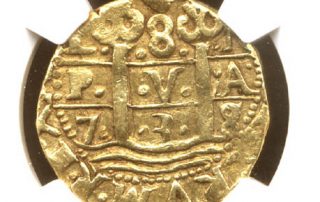In 1716 the Lima mint undertook the first significant modification of its gold coinage since 1697. Most of these changes proved short-lived, continuing only into 1717 in a simplified form. Changes to the one escudo proved to be permanent. On the two, four, and eight escudos, the pillar side converts its two horizontal dividers from solid lines into dotted lines and adds a further 13-17 dots framing the central letters and digits. It also adds a large many-rayed star above the denomination. The cross side also adds dots, initially 12 with 4 near the center of the cross. The last modification consists of 12 tear-shaped dots (gotas con lagrimas) emerging from the crosslets and creating a “tearful cross”. This familiar religious motif is unambiguous in suggesting a memorial issue.
In May of 1748 the Spanish Crown took control of the Lima mint, removing the previous owner and most of his employees. The new superintendent, Andres de Morales, whose job was to launch the new milled coinage by 1751, allowed several curious modifications of the gold cob coinage in its final years (1748-50). No gold cobs were struck at Lima after Dec. 16, 1750.










